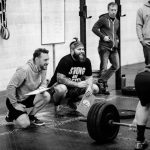Wrote this blog post a couple weeks ago and it seems to be a hot topic recently. Give it a read and let me know what you think.
First of all, understand that we always want to see you at the gym, but since this is our place of work, if you are super concerned about being contagious, we would appreciate a little time off. Just until you get a chance to fight the germs enough that you aren’t at risk to pass them on.
Secondly, remember that what we do at the gym is really hard and focusing on recovery while being healthy is hard enough, never mind doing it all while fighting a microscopic battle. So maybe if you do come in, working at a lesser intensity might be a lot smarter. Think about something to make you sweat, but it can’t be too hard and it can’t be too long.
Think about the following. During exercise, we cause damage at a cellular level. To fix the damage, the body initiates the inflammatory response which signals the body systems to transfer an increased amount of oxygen, nutrients and immunity cells to the site of damage in an effort to reverse the effects. If we are fighting something like the flu, the immune response needs an excess of all of those things simply to eradicate the bacteria or viruses responsible. So coming in to workout while you are sick is simply going to diminish the supplies that the body needs to get better.
Here is the general rule, if you’re experiencing symptoms that are “above the neck”, it is ok to take part in mild exercise. These include symptoms such as a light cold, runny nose, sneezing, and a minor sore throat. In my experience, a light training day can actually help open nasal passages and clear out congestion.
If symptoms are “below the neck”, such as chest congestion, heavy coughing, or an upset stomach, it’s best that you rest and allow your body the recovery it needs to start feeling better.
If you have a fever or flu-like symptoms, participating in any exercise can be very dangerous. Fevers can decrease muscle strength, impair coordination, and increase dehydration. On top of this, intense exercise can raise your internal body temperature which can cause serious problems if you already have a fever.
If you have any questions, do not hesitate to reach out.
Warm-up
Spend 2 minutes in Z1
Then, PVC mobility as a class
The Port Snatch warm-up
Strength
Power snatch – build to a TnG 3 rep
*weight should be challenging, but shouldn’t jeopardize form. Refer to 2/14
So last time we did a TnG power snatch it was a 5RM, those of us who were here and recorded your results can build off of that number. Think about trying to get between 5 and 10% more when doing 2 less reps.
Something to focus on when completing TnG snatches is the ability to be efficient on the way down AS WELL as on the way up. We work on all of the key points when snatching a barbell, but rarely do we use these cues to work on bringing it down the same way. Think straight line is a strong line right? On the way up that’s obvious, keep the bar path relatively straight and keep that bar close to the body. Same two rules apply when returning the bar to the ground. Keep the path straight and do not let that bar swing out and slam you in the hips. Working on the transition as you warm up will help when you are trying to move heavy weight.
WOD
“I Want to Break Free”
100 DU’s
50’ HS walk
50 cals AB
50 power cleans (135/95#)
50’ HS walk
100 DU’s
Good grinder today. each piece of this chipper requires some level of skill, minus the bike. Make sure you go through the progressions before starting the workout so you put yourself in a place to succeed. The most important thing is, no matter your ability level, everyone should be challenged equally. Your coach will make sure to help you all decide exactly where that is.


